
British postcard in the Picturegoer Series, London, no. W 10. Photo: Universal.

Belgian postcard by Les Editions d'Art L.A.B., Bruxelles, no. 2009. Photo: Metro-Goldwyn-Mayer. Margaret Sullavan and James Stewart in The Shop Around the Corner (Ernst Lubitsch, 1940). The French title was Rendez-vous.
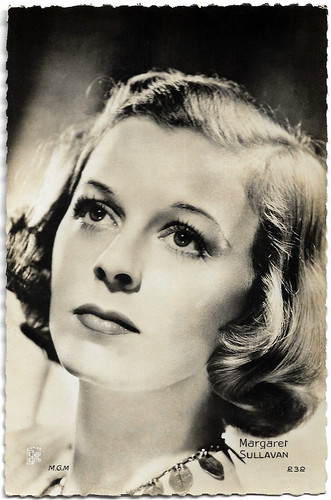
French postcard by EPC, no. 232. Photo: M.G.M.
A relationship behind the scenes
Margaret Brooke Sullavan Hancock was born in 1909 in Norfolk in the US state of Virginia. She was the daughter of the broker Cornelius Sullavan and his wife Garland Brooke. During her childhood, she attended several public schools. She graduated from Chatham Episcopal Institute in 1927. After this, she moved to Boston, where she moved into her sister's flat. Even as a child, Sullavan was a member of the theatre and danced in her spare time.
In the summer of 1928, she joined the local theatre University Players at Harvard. The owner of that theatre personally invited her to work for him after seeing her apprentice at the Copely Theatre. Her theatre debut followed in 1929 when she got a role in the touring play 'Strictly Dishonorable'. During these years, she met actor Henry Fonda, who was himself a member of University Players. They reportedly began a relationship behind the scenes back in 1929. They eventually married in 1931, but the marriage did not last long.
After only two months, a divorce was filed. In 1931, Sullavan had an interview with Lee Schubert, who was then preparing a play to be performed on Broadway. Although she had the flu during the interview, she got a role in his play 'A Modern Virgin', which ran in 1931 with a total of 53 performances. Sullavan soon began appearing in several plays on Broadway. After roles in 'If Love Were All', 'Happy Landing', 'Chrysalis' and 'Bad Manners', she replaced Marguerite Churchill in 'Dinner at Eight' in 1932.
It was not long before she was noticed by Hollywood producers. When she was offered the lead role in Only Yesterday (John M. Stahl, 1933), Sullivan decided to move west of the country. She signed a film contract with the film studio Universal Pictures, where she received $1,200 weekly for a period of three years. She arrived in Hollywood in 1933, on her twenty-fourth birthday. That same year, she was seen on the big screen in Only Yesterday. The film immediately made Sullavan a star.
Early on in her film career, she and Katharine Hepburn were considered rivals. This was mainly because they had a lot in common. In addition, Sullavan would regularly seduce friends of Hepburn, including Humphrey Bogart and James Stewart. She had a relationship with Stewart from 1932 to 1933. However, the only real serious relationship during this period was with director William Wyler. They got engaged and said yes to each other on 25 November 1934. The following year, she was featured in his film The Good Fairy. However, the marriage did not last long and the divorce was finalised in 1936.

Spanish collectors card by Marti y Mary, Barcelona. Photo: Universal.
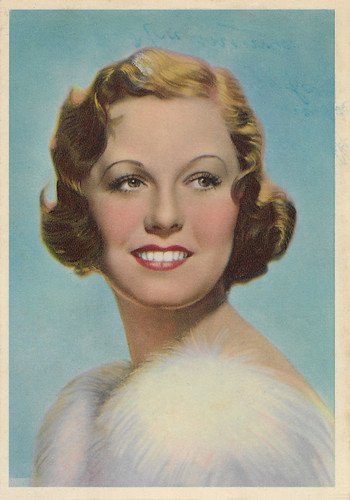
British postcard by Abdulla Cigarettes, no. 24. Photo: Universal.
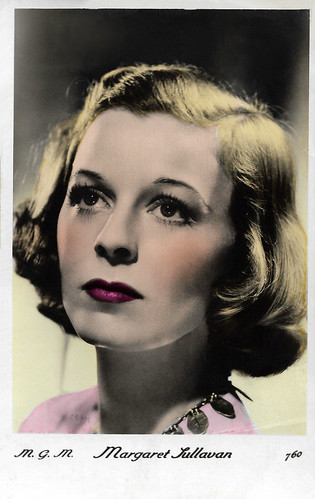
French postcard, no. 760. Photo: M.G.M.
A daring effort by the studio
In 1936, Margaret Sullavan starred in a film alongside James Stewart for the first time, Next Time We Love (Edward H. Griffith, 1936). This was the last film she made for Universal Pictures. Her contract was terminated and Sullavan briefly decided to return to theatre. She made 169 appearances in the Broadway play 'Stage Door' between October 1936 and March 1937, but the 1937 film version starred her old rival, Katharine Hepburn.
After this, she decided to return to the film industry. She got a contract with the Metro-Goldwyn-Mayer film studio. The first film she made for the studio was Three Comrades (Frank Borzage, 1938) alongside Robert Taylor. The film was a daring effort by the studio, as the Nazis were very powerful at the time and the film portrayed them in a negative light. However, it proved a great success and Sullavan was nominated for her first and only Academy Award for Best Actress.
Although she lost this one to Bette Davis for her role in Jezebel (1938), Sullavan became an international star. Thus, she was chosen as one of the audience favourites for the role of Scarlett O'Hara in the upcoming film Gone with the Wind. She was one of the first actresses considered for the role but was never a serious contender.
Sullavan married for the third time in 1936, this time to the powerful agent and producer Leland Hayward. In 1937, she gave birth to her first daughter, Brooke Hayward. The couple had two more children after this: daughter Bridget in 1939 and son William Bill in 1942. Sullavan was determined to give her children as normal a childhood as possible. Although she remained active in filmmaking herself during their childhood, she shielded her children from Hollywood.
Sullavan also starred again alongside James Stewart in The Shopworn Angel (H.C. Potter, 1938). In it, she played a spoilt and alcoholic actress who falls for the charms of an everyday citizen. Although Sullivan's voice had been praised since the beginning of her career, her musical numbers were dubbed by singer Mary Martin. She was not much later personally asked by actress Joan Crawford to be her counterpart in her upcoming film The Shining Hour (Frank Borzage, 1938). Although the film crew advised Crawford against offering Sullavan the role for fear she would overshadow her, she was determined to work with her.
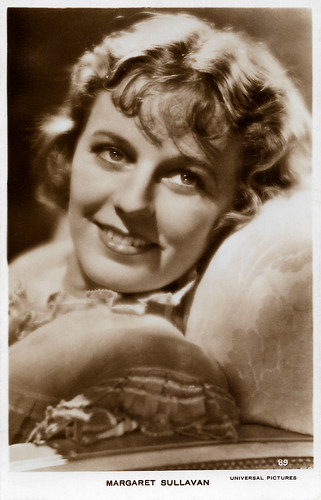
British Real Photograph postcard, no. 89. Photo: Universal Pictures.

British postcard in the Film Partners Series, London, no. P 199. Photo: Universal. James Stewart and Margaret Sullavan in Next Time We Love (Edward H. Griffith, 1936).

British postcard in the Filmkurier Series, London, no. 143. Photo: Universal Pictures.
Disowned by her children
After her role in The Shining Hour, Margaret Sullavan was again cast opposite James Stewart in The Shop Around the Corner (Ernst Lubitsch, 1940). In it, she played Klara Novak, the role for which she is probably best remembered. Although the film became a huge success, it went unnoticed at the Oscars.
Not much later, she again starred alongside Stewart in The Mortal Storm (Frank Borzage, 1940). After this, her contract with MGM was broken. Sullavan attempted a freelance career but was unable to find work after a role in Cry 'Havoc' (Richard Thorpe, 1943).
Her private life was not going according to plan either. Her daughter Brooke and son Will both had mental problems and had to be placed in an institution. When her marriage to Hayward also fell apart, Sullavan became depressed. They divorced in 1947 and Sullavan moved several times after this.
She achieved a few more successes in the theatre. For instance, she performed in the play 'The Voice of the Turtle' from 1943 to 1948. However, her personal problems affected her career. Critics spoke increasingly negatively about her acting skills. In 1950, Sullavan made her last film appearance in No Sad Songs for Me (Rudolph Maté, 1950). Between 1952 and 1956, she appeared in the plays 'The Deep Blue Sea', 'Sabrina Fair' and 'Janus', after which she decided to retire.
Her depression worsened. She was disowned by her children Bridget and Bill. After retirement, she only spoke negatively about her experiences with Hollywood and blamed her film career for, in her own words, failing her as a mother. In addition, she developed otosclerosis, which resulted in her becoming hard of hearing. She was found dead in her flat on 1 January 1960. It was later found that she had committed suicide via an overdose of barbiturates.
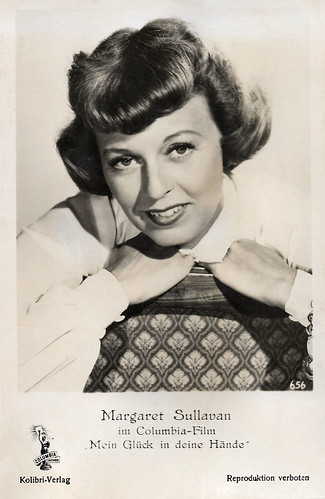
West-German postcard by Kolibri-Verlag, no. 656. Photo: Columbia. Margaret Sullavan in No Sad Songs for Me (Rudolph Maté, 1950).

Dutch postcard, no. A.X. 314. Photo: Europa - Columbia.
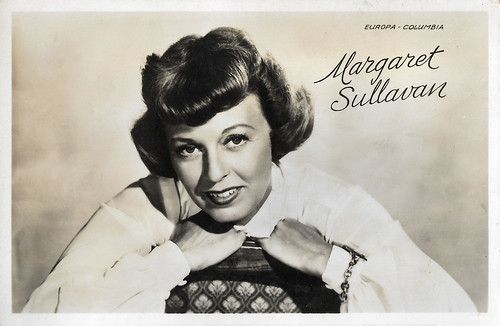
Belgian postcard, no. 3328. Photo: Europa-Columbia.
Source: Wikipedia (Dutch and German) and IMDb.
No comments:
Post a Comment